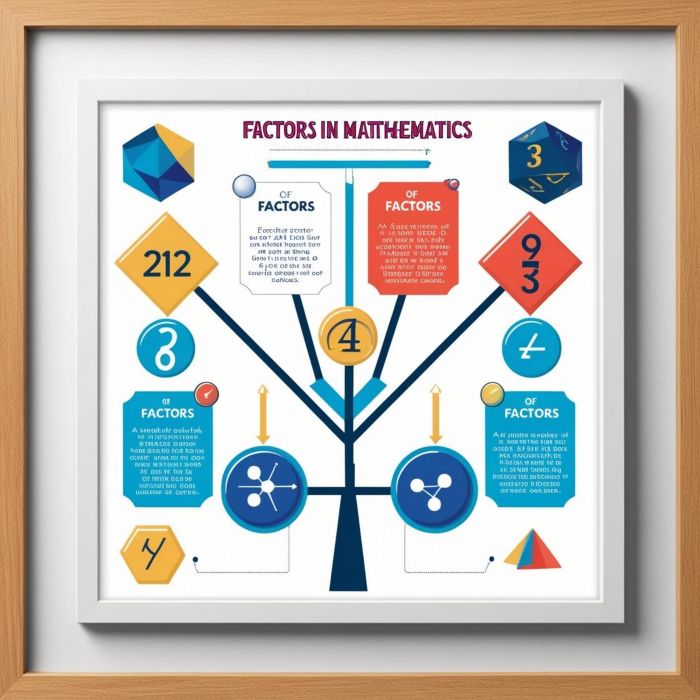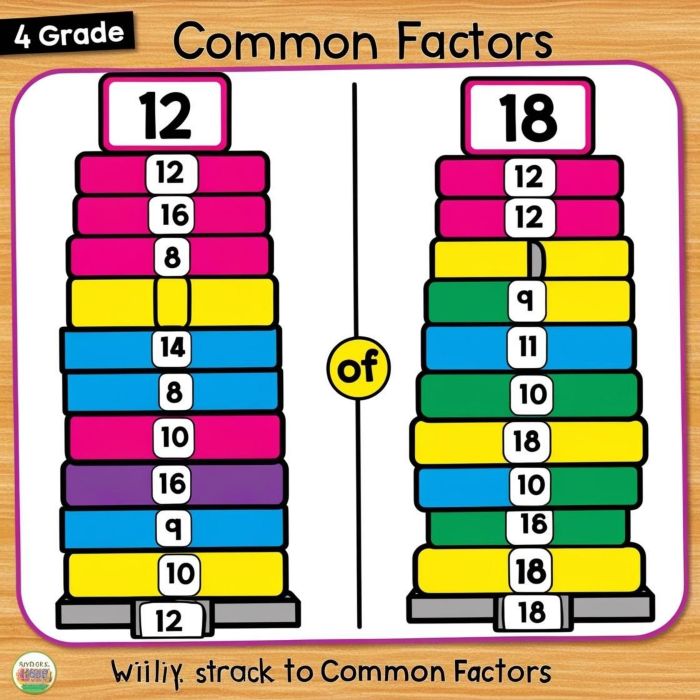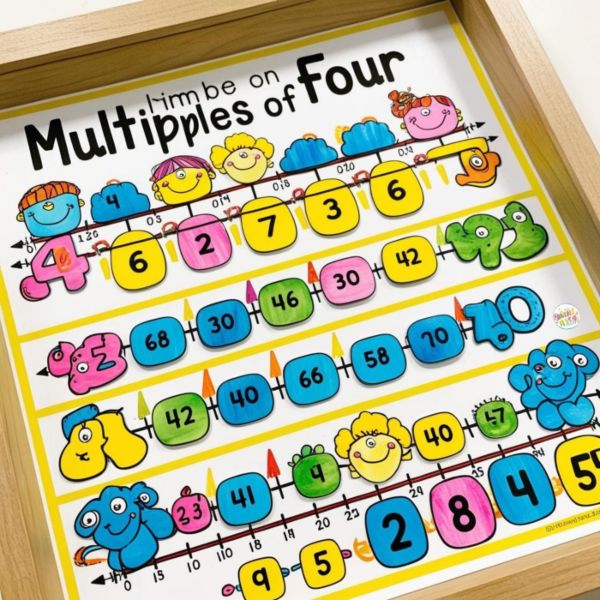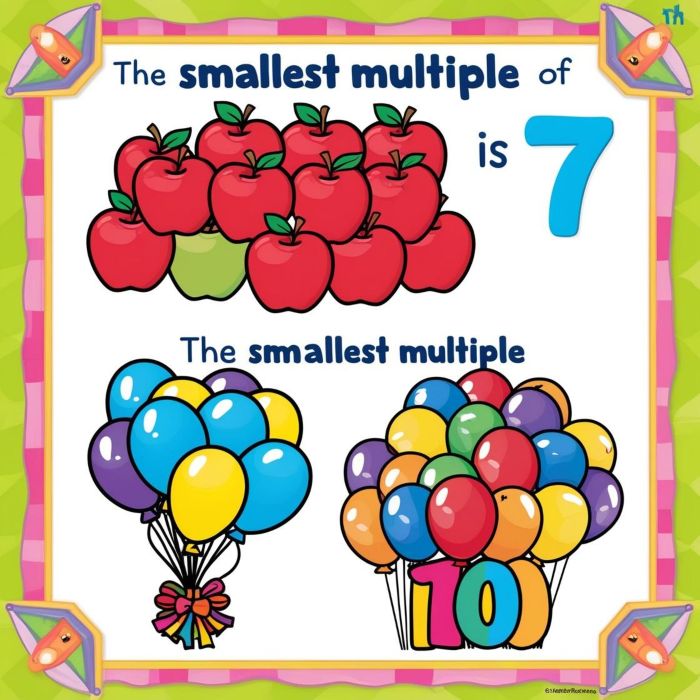Factors, Common factors, Multiples
Welcome to the world of Factors and Multiples! In this lesson, we will learn what these terms mean, how they help us understand numbers better, and how we can use them in math.
What Are Factors?

Factors are numbers that, when multiplied together, make a product. That is to say, if you multiply two numbers, the two numbers you used are factors of the product.
Example
Consider the number 12. What are the factors of 12?
1 × 12 = 12
2 × 6 = 12
3 × 4 = 12
Thus, factors of 12 are 1, 2, 3, 4, 6, and 12.
What Are Factor Pairs?

A factor pair is a pair of factors whose product is the same. For instance, the following are the factor pairs for 12:
(1, 12)
(2, 6)
(3, 4)
Every two numbers can be multiplied to give 12.
Interesting Fact
The smallest factor of any number is always 1, and the greatest factor is the number itself! For example, the smallest factor of 12 is 1, and the largest factor is 12.
What Are Common Factors?

Common factors are any numbers that divide two or more numbers evenly, that is without a remainder. Common factors are the common divisors of two or more numbers. To find common factors we make a list of each number's factors and then determine which factors appear on both lists.
Example: Finding Common Factors of 12 and 18
Factors of 12 : 1, 2, 3, 4, 6, 12
Factors of 18: 1, 2, 3, 6, 9, 18
Common numbers on both lists: 1, 2, 3, and 6.
So, the common factors of 12 and 18 are: 1, 2, 3, and 6.
GCF
We take the common factors and the greatest common factor is the largest number in the list of common factors. In our example, it is 6. When we work with the GCF, we are able to simplify fractions and solve problems like dividing things into equal groups.
How Do Common Factors Help Us?
We use common factors to simplify fractions and solve problems such as dividing things into equal groups.
Simplifying fractions: To simplify fractions we divide both top and bottom by their greatest common factor.
For instance,
-
12
-
18
-
18
-
12
can be streamlined by dividing both 12 and 18 by 6, which yields
-
2
-
3
-
3
-
2
Dividing into Equal Groups: If you have 24 apples and 36 oranges and want to divide the fruit into the largest number of equal groups, the common factors of 24 and 36 will assist you. Through the greatest common factor, you will be able to make 12 equal groups.
Word Problems: Using common factors often helps to solve everyday problems such as equally sharing a number of candies. Assuming you have 18 candies and 6 people: there is a common factor among 18 and 6, which is 6. Therefore each person received 3 candies.
Example of Common Factors
Factors of 8 and its common factors of 12
Factors of 12: 1,2,3,4,6,12
Common factors: 1, 2, and 4. The highest common factor is 4.
Common Factors of 20 and 30:
Factors of 20: 1, 2, 4, 5, 10, 20
Factors of 30: 1, 2, 3, 5, 6, 10, 15, 30
Common factors: 1, 2, 5, and 10. The highest common factor is 10.
How to Find Common Factors
List the factors: Write down the factors of each number.
Find the common ones: Find number that occurs in both lists.
Choose the largest: The greatest common number is the greatest common factor (GCF).
What Are Multiples?

A multiple is a number you get by multiplying a number by 1, 2, 3, 4, and so on. It's like counting in groups of numbers.
Example
Let's find the first few multiples of 4. We multiply 4 by 1, 2, 3, 4, and so on:
4 × 1 = 4
4 × 2 = 8
4 × 3 = 12
4 × 4 = 16
4 × 5 = 20
So, the multiples of 4 are 4, 8, 12, 16, 20, and so on. The sequence never ends!
Determining if a Number is a Multiple
To check if one number is a multiple of another, divide the first number by the second number. If the division results in a whole number (no remainder), then the first number is a multiple of the second.
Example
Is 24 a multiple of 6?
24 ÷ 6 = 4 (No remainder)
Since the division results in a whole number (4), we know that 24 is a multiple of 6!
Fun Fact About Multiples

Do you know? The smallest multiple of any number is that number itself! Take the smallest multiple of 7: it's 7; take the smallest multiple of 10: it's 10.
Quiz Time!
Now it's your turn to practice all this you have learned so far! You can use these questions as an exercise to test whether you have indeed grasped everything you learned about factors and multiples.
1. Factors of 24
-
a) 1, 2, 3, 4, 5, 6
-
b) 1, 2, 3, 4, 6, 8, 12, 24
-
c) 2, 4, 6, 8, 12
2. Which of the following is NOT a multiple of 3?
-
a) 9
-
b) 12
-
c) 17
-
d) 18
3. What are the common factors of 8 and 12?
-
a) 1, 2, 3
-
b) 1, 2, 4, 8
-
c) 1, 2, 4, 6
4. Which number is a multiple of both 5 and 6?
-
a) 10
-
b) 12
-
c) 30
-
d) 18
5. Which of the following is a factor of 36?
-
a) 4
-
b) 5
-
c) 6
-
d) 7
FAQs
How do you explain factors and multiples to a child?
Factors are numbers you can multiply together to achieve a product. Multiples are results you get after multiplying any number by 1, 2, 3, and more. Take the case of 6 and its factors as 1, 2, 3, 6. Likewise, a multiple of 6 means 6, 12, 18, etc.
What is a math multiple?
Multiples are those numbers that you get from the multiplication of a number by whole numbers (1, 2, 3, etc.). So, the multiples of 4 are 4, 8, 12, 16, and many more. A multiple of a number keeps growing, adding that number repeatedly.
Is 8 a factor and multiple?
Yes, 8 is a multiple and a factor. The numbers are 16 and 24 because 8 × 2 = 16, 8 × 3 = 24. It is also a multiple of itself. A multiple of 8 is: 8, 16, 24, 32, 40 and so on.
What is the definition of a factor in mathematics?
A factor is a number that divides another number without leaving a remainder. For example, the factors of 12 are 1, 2, 3, 4, 6, and 12. Factors are the building blocks that multiply together to form a product.
Practice Worksheet
Easy Level Worksheets
Intermediate Level Worksheets
Advanced Level Worksheets
Related Links
CBSE Schools In Popular Cities
- CBSE Schools in Bangalore
- CBSE Schools in Mumbai
- CBSE Schools in Pune
- CBSE Schools in Hyderabad
- CBSE Schools in Chennai
- CBSE Schools in Gurgaon
- CBSE Schools in Kolkata
- CBSE Schools in Indore
- CBSE Schools in Sonipat
- CBSE Schools in Delhi
- CBSE Schools in Rohtak
- CBSE Schools in Bhopal
- CBSE Schools in Aurangabad
- CBSE Schools in Jabalpur
- CBSE Schools in Jaipur
- CBSE Schools in Jodhpur
- CBSE Schools in Nagpur
- CBSE Schools in Ahmednagar
- CBSE School In Tumkur











